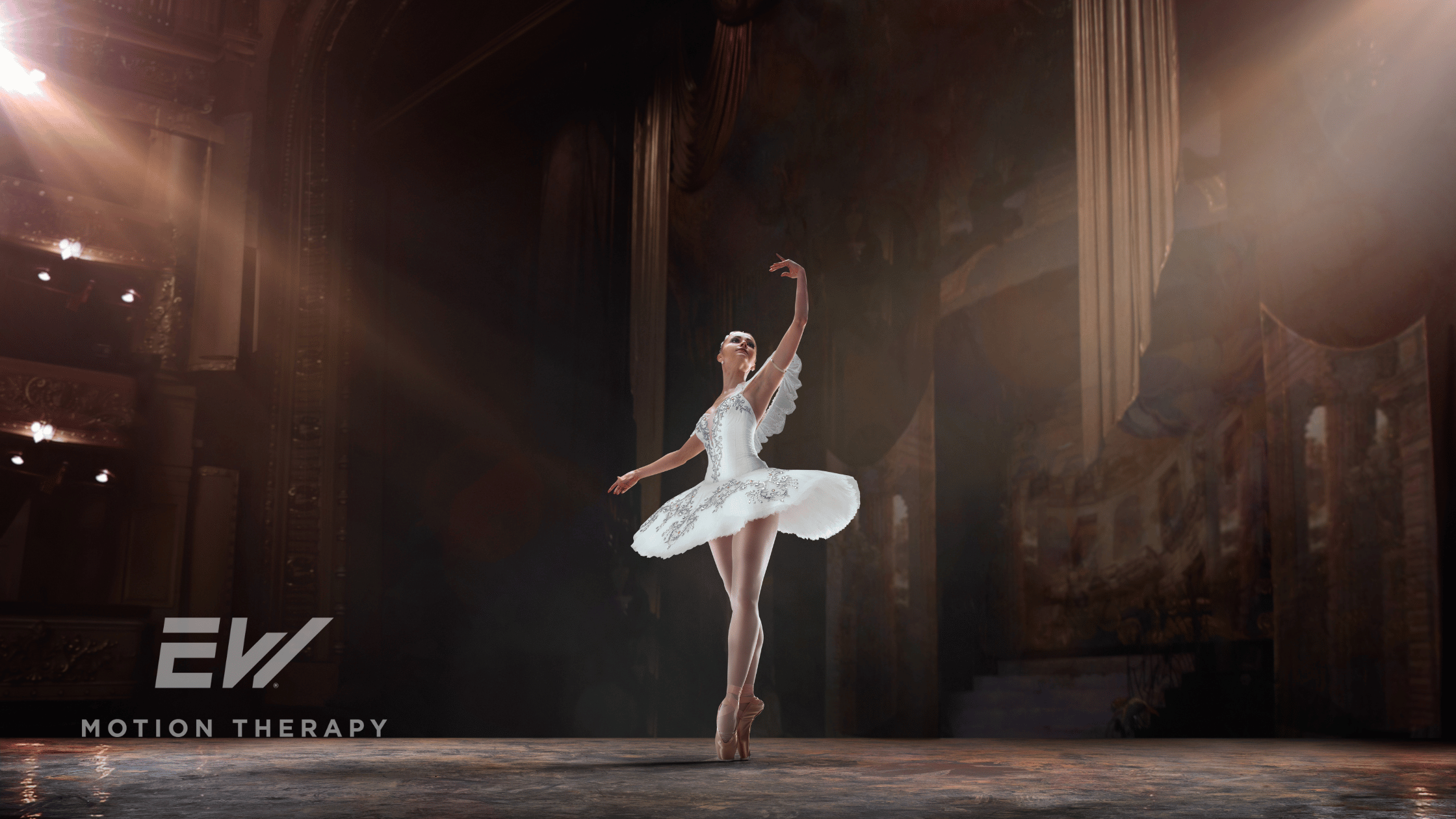How Dancers Can Improve Their Turns: A Full-Body Approach

Licensed Physical Therapist, PT, DPT // EW Motion Therapy Trussville
Turning in dance is a technical skill that looks effortless when executed well. However, behind that seamless spin is a full-body movement requiring coordination, strength, balance, and precision. Whether you are working on pirouettes, fouetté turns, or chaînés, mastering turns is essential for all styles of dance, from ballet to contemporary to jazz.
Understanding the mechanics of turns can help dancers refine their technique and avoid common pitfalls. In this article, we’ll break down how each part of the body contributes to turns, recognize signs of dysfunction, and explore ways to improve turns, including how physical therapy can aid in perfecting this challenging skill.
The full-body nature of turns in dance
Turns are complex movements that rely on the coordinated effort of the entire body. Each body part plays a crucial role in ensuring the turn is balanced, smooth, and controlled. Let’s explore how each part contributes:
The core
The core is the foundation of all dance movements, and turns are no exception. A strong core provides the necessary stability and balance, allowing dancers to control their movement while spinning. When the core muscles (abdominals, obliques, and lower back) are engaged, the dancer can maintain an upright posture, keeping the body aligned and preventing wobbling or falling off balance during the turn.
Without proper core engagement, turns can feel unstable, leading to loss of control and possibly injury. Strengthening core muscles not only improves turns but also enhances overall dance performance.
The arms
The arms help create momentum and balance during turns. Arm placement should be precise whether you’re preparing for a pirouette or any other turn. Proper port de bras (the carriage of the arms) ensures that the upper body stays aligned with the lower body.
For turns like chaînés or fouettés, the arms help initiate and control the movement. The momentum from arm rotation can help propel the turn, while correct positioning helps maintain balance. Incorrect arm placement can cause the dancer to twist or lose alignment, throwing the turn off-center.
The shoulders and upper back
While the arms help with balance and momentum, the shoulders and upper back are essential in maintaining alignment. Dancers must avoid hunching or slouching, as this disrupts the axis of the turn. The upper back and shoulder muscles should remain engaged, keeping the chest open and the spine long.
Proper posture during turns keeps the body aligned over the supporting leg, ensuring the turn stays balanced. It also helps prevent unnecessary tension in the neck and shoulders, which can lead to stiffness and discomfort during and after turning.
The hips and pelvis
The hips are responsible for alignment and mobility in turns. Keeping the pelvis level and squared is key for preventing over-rotation or imbalance. The hips must remain stable while the dancer rotates, particularly during one-legged turns like pirouettes. Hip instability or misalignment can throw off the center of gravity, making it difficult to execute multiple turns or maintain balance.
Additionally, tight or weak hip muscles can limit the range of motion and affect the smoothness of turns. Stretching and strengthening the hip flexors and surrounding muscles can greatly improve turning ability.
The legs
The legs are pivotal in turns, from the initial preparation to the landing. Proper placement of the supporting leg, especially during relevé (the act of rising onto the ball of the foot), is critical for balance and control. The working leg (the leg that comes into passé or another position during the turn) must also be positioned correctly to prevent loss of balance.
Dancers should focus on keeping their supporting leg strong and straight, and their working leg in proper alignment to maintain control. Weak or poorly positioned legs can lead to unsuccessful turns and may even cause strain or injury over time.
The ankles and feet
Ankles and feet are the final link in the chain of successful turns. The ability to balance on the ball of the foot, or sometimes the full foot, is crucial for executing turns smoothly. Dancers must engage the muscles of the feet to stabilize themselves during turns. Ankle instability can lead to wobbling, falling out of the turn, or even injury.
Training the ankles for strength, stability, and flexibility in the feet helps improve the overall quality of turns. Regular stretching, strengthening exercises, and practicing foot placement can prevent common issues like sickling (when the foot rolls inward) or wobbling during turns.
Warning signs of dysfunctional turns
While turns may look simple, there are several indicators that a dancer’s technique needs improvement. Common signs of dysfunctional turns include:
- Falling out of turns: If you frequently fall or stumble out of your turns, it may indicate instability in your core, hips, or legs.
- Loss of balance mid-turn: Losing balance during the rotation suggests that your alignment is off or your body isn’t working together as a cohesive unit.
- Wobbling or hopping during turns: A wobbly turn can indicate weak ankles, poor core engagement, or incorrect foot placement. Hopping, rather than smoothly rotating, often points to instability in the supporting leg.
- Over-rotation or under-rotation: Struggling to complete the rotation or over-rotating suggests issues with momentum control, often related to arm placement, core strength, or hip alignment.
- Tension in the neck, shoulders, or back: Excessive tension in the upper body during turns indicates poor posture or a lack of coordination between the upper and lower body.
Tips to improve turns
Improving turns takes time, practice, and attention to detail. Here are some tips to help dancers refine their turning technique:
- Strengthen your core: Engage in exercises that target the core muscles, such as planks, Pilates, or yoga. A strong core helps maintain balance and alignment during turns.
- Focus on alignment: Pay attention to your posture. Keep your shoulders relaxed, chest open, and spine straight. Ensure that your hips and pelvis are level and squared with the rest of your body.
- Develop hip strength: Strong hips are essential for stability and control during turns. The muscles around the hips, especially the hip abductors and flexors, help maintain balance and alignment throughout the movement. Exercises such as clamshells, side-lying leg lifts, and resistance band work can improve hip strength, allowing for better control of the working leg in positions like passé and arabesque.
- Work on foot and ankle strength: Incorporate foot and ankle strengthening exercises into your routine. Calf raises, resistance band exercises, and balance training can improve ankle stability, leading to better turns.
- Practice spotting: Spotting (the act of keeping your gaze focused on a single point as you turn) is essential for maintaining balance and preventing dizziness during multiple turns. Practice spotting in the mirror to improve your focus and control.
- Control arm placement: Ensure your arms are in the correct position to generate momentum and maintain balance. Practice turning with precise port de bras to avoid throwing yourself off-center.
- Stretch regularly: Stretching your hips, legs, and back helps improve flexibility and range of motion, making turns smoother and more controlled.
How physical therapy can help improve turns
Dancers may struggle with turns due to underlying muscle imbalances, injuries, or poor alignment. Physical therapy can play a crucial role in enhancing turning ability by addressing these issues and focusing on the mechanics of the body. A physical therapist can assess your movement patterns, identify any weaknesses or imbalances, and create a personalized plan to address them. Here’s how physical therapy can help:
- Correct muscle imbalances: Physical therapists can help identify weak muscles that may be affecting your turns. They can provide exercises to strengthen these muscles and improve overall balance and stability.
- Improve flexibility and mobility: A therapist can recommend stretches and mobility exercises to increase flexibility in key areas like the hips, ankles, and shoulders, helping you move more freely and improving turn quality.
- Enhance proprioception: Proprioception, or the body’s ability to sense its position in space, is crucial for maintaining balance during turns. Physical therapy can include exercises that improve proprioceptive awareness, such as balance training, single-leg exercises, and coordination drills. By enhancing proprioception, dancers can improve their body control and responsiveness, which leads to more precise and stable turns.
- Address injuries or pain: If you’ve sustained an injury or are experiencing pain during turns, physical therapy can aid in recovery by treating the root cause and helping you safely return to dance with improved technique.
Turning is one of the most demanding yet rewarding skills in dance. By understanding the full-body nature of turns and addressing any signs of dysfunction early, dancers can improve their technique and prevent injury. Incorporating core strengthening, ankle stabilization, proper alignment, and working with a physical therapist can help ensure that your turns are controlled, balanced, and executed with grace. We love helping our dancers at EW Motion Therapy build strength, improve proprioception, and prevent injuries so they can continue the sport they love. To learn more about how physical therapy can be an asset to your dance career, click the button below to download our answers to 20 frequently asked questions.


